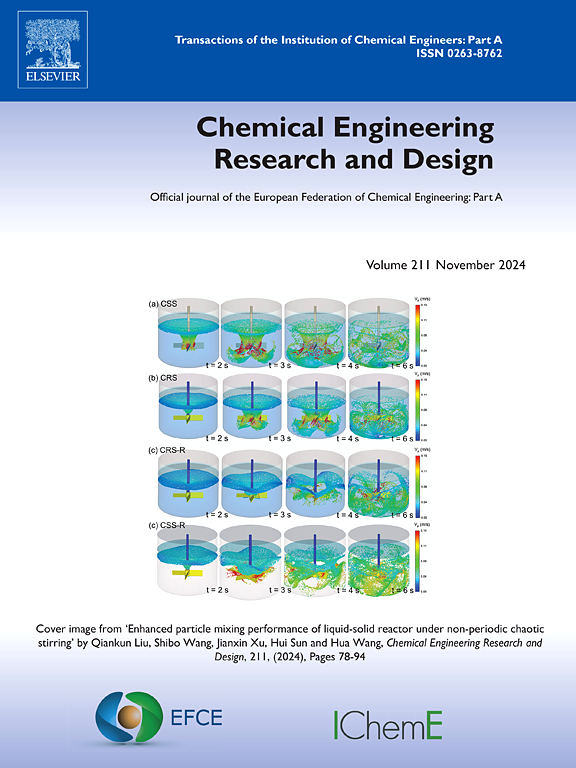利用锆-巯基丁二酸金属有机框架集成混合基质膜提高水净化效率:合成、综合表征和性能见解
IF 3.7
3区 工程技术
Q2 ENGINEERING, CHEMICAL
引用次数: 0
摘要
基于金属有机框架(MOF)的膜的开发已显示出解决工业废水处理瓶颈的巨大潜力。本研究强调了一种以巯基丁二酸(MA)为配体的锆基 MOF(Zr-MA-MOF)制造混合基质膜(MMMs)的新方法。这些混合基质膜是用聚醚砜(PES)基质嵌入不同的纳米填料(0.25、0.5、0.75 和 1.0 wt%)制成的。因此,本研究调查了 Zr-MA-MOF 负载对膜形态和功能性能的影响,特别是对纯水通量、盐类、重金属和染料的去除、防污性能和长期稳定性的影响。负载量为 0.75 wt% Zr-MA-MOF 的 MMM 表现突出,水通量高达 71 Lm-2h-1,对二价硫酸镁(MgSO4)、一价氯化钠(NaCl)和染料(包括亚甲基蓝、刚果红和玫瑰红)的去除率分别为 80%、74% 和 99%。Zr-MA-MOF 膜的重金属抑制能力同样出色,对砷、铬和铝离子的抑制率分别为 90%、92% 和 94%。此外,通量回收率高达 92%,显示了可持续工业应用的巨大潜力。这些研究结果表明,将 Zr-MA-MOF 集成到膜技术中,在水处理过程中具有巨大的潜力,既能满足人类消费需求,也能满足工业应用中的各种废水处理需求。本文章由计算机程序翻译,如有差异,请以英文原文为准。
Enhancing water purification efficiency with zirconium-mercaptosuccinic acid metal-organic framework integrated mixed matrix membranes: Synthesis, comprehensive characterization, and performance insights
The development of metal-organic framework (MOF) based membranes has shown great potential to address the bottlenecks in industrial wastewater treatment. This study emphasized a novel approach involving a zirconium-based MOF (Zr-MA-MOF) with mercaptosuccinic acid (MA) as a ligand for fabricating mixed matrix membranes (MMMs). These MMMs were fabricated using a polyethersulfone (PES) matrix embedded with different nanofiller loadings of 0.25, 0.5, 0.75, and 1.0 wt%. Consequently, this study investigated the impact of Zr-MA-MOF loadings on the membrane morphology and functional performance, particularly focusing on pure water flux, rejection of salts, heavy metals, and dyes, antifouling properties, and long-term stability. The MMM with a loading of 0.75 wt% Zr-MA-MOF emerged as a standout performer, delivering an exceptional water flux of 71 Lm−2h−1 and rejection efficiencies of 80, 74, and 99 % for divalent magnesium sulfate (MgSO4), monovalent sodium chloride (NaCl), and dyes (including methylene blue, congo red, and rose bengal), respectively. The heavy metal rejection capabilities of the Zr-MA-MOF membrane were equally remarkable, with rejection rates of 90, 92, and 94 % for arsenic, chromium, and aluminum ions, respectively. Furthermore, a flux recovery ratio of 92 % showcased the great potential for sustainable industrial applications. These findings revealed that the integration of Zr-MA-MOF into membrane technology holds great potential for water treatment processes, catering to both human consumption and industrial applications for diverse wastewater treatment needs.
求助全文
通过发布文献求助,成功后即可免费获取论文全文。
去求助
来源期刊

Chemical Engineering Research & Design
工程技术-工程:化工
CiteScore
6.10
自引率
7.70%
发文量
623
审稿时长
42 days
期刊介绍:
ChERD aims to be the principal international journal for publication of high quality, original papers in chemical engineering.
Papers showing how research results can be used in chemical engineering design, and accounts of experimental or theoretical research work bringing new perspectives to established principles, highlighting unsolved problems or indicating directions for future research, are particularly welcome. Contributions that deal with new developments in plant or processes and that can be given quantitative expression are encouraged. The journal is especially interested in papers that extend the boundaries of traditional chemical engineering.
 求助内容:
求助内容: 应助结果提醒方式:
应助结果提醒方式:


